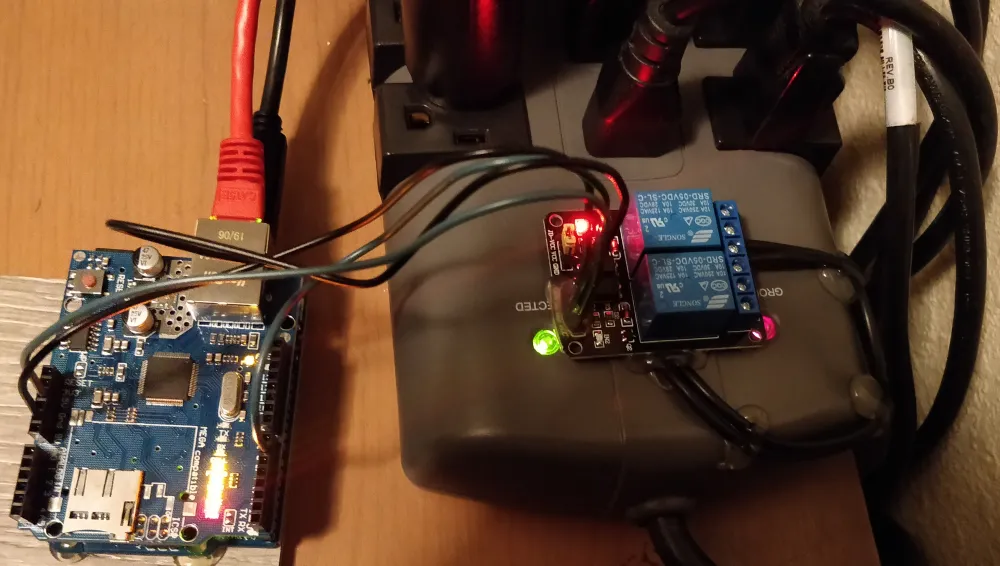Arduino Controlled Power Strip.
After having the cisco lab online for a bit, I didn’t realize that it would more than double my power bill. Looking for a way to turn it off remotely and I got the idea from a colleague to make my own with Arduino and he helped put it together.

Next time I should take some progress pictures.
Instead As a summary:
- Unsoldered the switch
- Used a multimeter to test which 2 sections of the board completes the circuit.
- Soldered 2 wires to the internal board
- Connect those to the relay board and attach both to the power strip.
- wire up the Arduino to the relay and finish coding the Arduino.
I wanted the circuit normally open since it will be off most of the time. Then the relay can close and complete the circuit when I remotely turn it on.
To turn it on I just open a new tab and go to http://ipAddress/$1
To turn it of I just open a new tab and go to http://ipAddress/$0
I’m not sure why a new tab has to be used and why text based browsers like Lynx or Curl don’t work. I guess that is for a future update when I have time.
I did wait until the weekend to test it because I was paranoid that it would do something unexpected or catch on fire while I wasn’t home.
Update: It has had no problems and has been stable and I’ve been using it for a few weeks now as of October 9th.
Here is my Arduino Code
#include <SPI.h>
#include <Ethernet.h>
boolean incoming = 0;
int PowerRelayK1 = 6;
byte mac[] = { 0x02, 0x02, 0x02, 0x00, 0x00, 0x01 };
byte ip[] = { 10, 3, 72, 98 };
byte gateway[] = { 10, 3, 72, 254 };
byte subnet[] = { 255, 255, 252, 0 };
EthernetServer server = EthernetServer(80);
void setup()
{
Serial.begin(9600);
Serial.print("Power is on ");
pinMode(PowerRelayK1, OUTPUT);
digitalWrite(PowerRelayK1,HIGH);
Serial.print("Relay output set");
// initialize the ethernet device
Ethernet.begin(mac, ip, gateway, subnet);
Serial.print("network is on");
/*start the Ethernet connection and get an IP via DHCP:
Serial.println("Initialize Ethernet with DHCP:");
if (Ethernet.begin(mac,ip) == 0) {
Serial.println("Failed to configure Ethernet using DHCP");
if (Ethernet.hardwareStatus() == EthernetNoHardware) {
Serial.println("Ethernet shield was not found. Sorry, can't run without hardware. :(");
} else if (Ethernet.linkStatus() == LinkOFF) {
Serial.println("Ethernet cable is not connected.");
}
// no point in carrying on, so do nothing forevermore:
while (true) {
delay(1);
}
}
// print your local IP address:
//Serial.print("My IP address: ");
//Serial.println(Ethernet.localIP());
*/
Serial.print("My IP address: ");
Serial.println(Ethernet.localIP());
server.begin();
}
void loop()
{
EthernetClient client = server.available();
if (client) {
// an http request ends with a blank line
boolean currentLineIsBlank = true;
while (client.connected()) {
if (client.available()) {
char c = client.read();
// if you've gotten to the end of the line (received a newline
// character) and the line is blank, the http request has ended,
// so you can send a reply
//reads URL string from $ to first blank space
if(incoming && c == ' '){
incoming = 0;
}
if(c == '$'){
incoming = 1;
}
//Checks for the URL string $1 or $0
if(incoming == 1){
//Serial.print("debugging c value is: ");
//Serial.println(c);
if(c == '0'){
digitalWrite(PowerRelayK1,HIGH);
client.println("HTTP/1.1 200 OK");
client.println("Content-Type: text/html");
client.println();
client.println("<cke:html><cke:body bgcolor=#FFFFFF>RELAY IS OFF!</cke:body></cke:html>");
}
if(c == '1'){
digitalWrite(PowerRelayK1,LOW);
client.println("HTTP/1.1 200 OK");
client.println("Content-Type: text/html");
client.println();
client.println("<cke:html><cke:body bgcolor=#FFFFFF>RELAY IS ON!</cke:body></cke:html>");
}
}
if (c == '\n') {
// you're starting a new line
currentLineIsBlank = true;
}
else if (c != '\r') {
// you've gotten a character on the current line
currentLineIsBlank = false;
}
}
}
// give the web browser time to receive the data
delay(1);
//Serial.println(digitalRead(7));
// close the connection:
client.stop();
}
/*---Ethernet DHCP Renawal Code Starts Here------------------------------------------------------
switch (Ethernet.maintain()) {
case 1:
//renewed fail
//Serial.println("Error: renewed fail");
break;
case 2:
//renewed success
//Serial.println("Renewed success");
//print your local IP address:
//Serial.print("My IP address: ");
//Serial.println(Ethernet.localIP());
break;
case 3:
//rebind fail
//Serial.println("Error: rebind fail");
break;
case 4:
//rebind success
//Serial.println("Rebind success");
//print your local IP address:
//Serial.print("My IP address: ");
//Serial.println(Ethernet.localIP());
break;
default:
//nothing happened
break;
}
*/
//---Ethernet DHCP Renawal Code Ends Here--------------------------------------------------------
}Here are some of the useful sources I found along the way.
https://www.digikey.com/en/maker/blogs/2018/how-to-get-started-with-arduino
https://www.instructables.com/id/Arduino-Ethernet-Shield-Tutorial/
https://codebender.cc/sketch:1138#Web%20Server.ino
https://www.arduino.cc/reference/en/language/functions/digital-io/digitalread/
http://www.circuitbasics.com/setting-up-a-5v-relay-on-the-arduino/
https://randomnerdtutorials.com/guide-for-relay-module-with-arduino/
https://upload.wikimedia.org/wikipedia/commons/c/c9/Pinout_of_ARDUINO_Board_and_ATMega328PU.svg